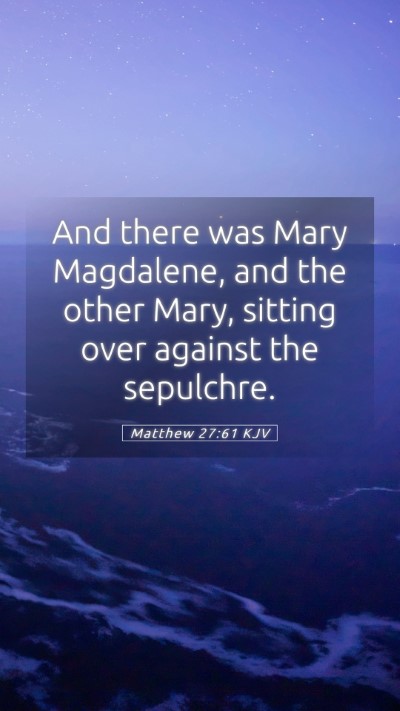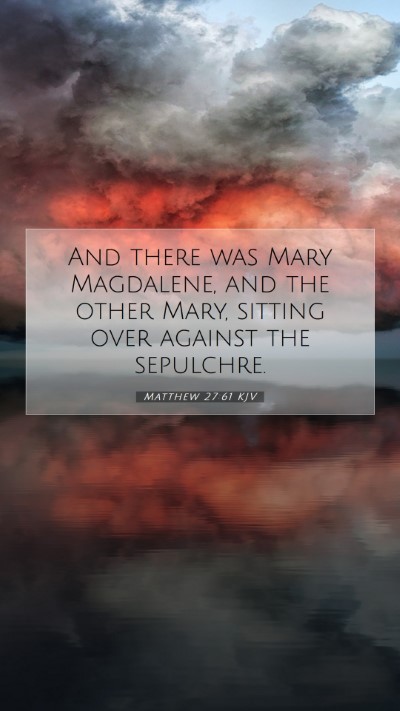Bible Verse: Matthew 27:61
“And there was Mary Magdalene, and the other Mary, sitting over against the sepulchre.”
This passage from Matthew 27:61 offers profound insight into the events following the crucifixion of Jesus Christ. In this verse, the presence of the two Marys at the tomb serves several significant interpretive functions. Below, we will explore the meaning of this Bible verse through a combined analysis of insights from public domain commentaries by Matthew Henry, Albert Barnes, and Adam Clarke.
Overview of Matthew 27:61
After the death of Jesus, two Marys—Mary Magdalene and the other Mary (often thought to be the mother of James and Joseph)—are depicted as sitting opposite the tomb where Jesus was laid. Their presence emphasizes themes of mourning, devotion, and the anticipation of resurrection.
Meaning and Interpretation
- Mary Magdalene's Role: Commentaries by Matthew Henry depict Mary Magdalene as a devoted follower of Jesus, who had once been freed from seven demons. Her presence at the tomb signifies her steadfast loyalty and deep emotional connection to Jesus. This reflects the Bible verse understanding that true discipleship often involves deep personal experiences of faith and gratitude.
- The Other Mary: The identity of the other Mary plays a crucial role in the broader narrative of the resurrection. Barnes points out that her presence alongside Mary Magdalene serves to validate their witness. This aligns with the context of Scripture analysis, where multiple witnesses are necessary to establish truth.
- The Timing: Adam Clarke notes the timing of their visit, highlighting that it was just after the burial of Jesus, which marks the beginning of a significant transformation with the forthcoming resurrection. This timing offers insight into understanding Scripture, as it emphasizes the movement from despair to hope.
- Contrast of Emotions: The contrast between the grief of the two Marys and the hope of the empty tomb is essential for grasping the full meaning of this passage. Matthew Henry remarks that even in their sorrow, their situation set the stage for the great news of the resurrection, evolving into a discussion on Bible verse explanations regarding the transformative power of faith amidst despair.
- Significance of the Tomb: The sepulchre is not just a burial place but a symbol of transition. Barnes interprets it as a representation of death that would soon be overturned by Christ's victory. This theme of resurrection is central to many Bible study lessons and is pivotal in Christian theology.
- Impact on the Disciples: Their presence also serves as a narrative device that foreshadows the announcement of Jesus's resurrection to the disciples. It illustrates the important role women played in Jesus's ministry and the early church, providing a basis for Biblical exegesis that highlights gender dynamics in scripture.
- Theological Reflections: Overall, this verse invites deeper theological reflection about Jesus' mission and the nature of true discipleship; it encourages believers to embody a faith that persists in the face of loss. This aligns well with Bible verse commentary that calls for a living faith that acts upon the hope of salvation.
Practical Applications
Understanding Matthew 27:61 encourages personal reflection on how one can remain faithful in times of grief and uncertainty. The presence of the Marys is a powerful reminder of devotion and hope, serving as a model for believers today:
- Perseverance in Faith: Like the Marys, Christians are called to maintain their faithfulness during challenging times. This applies to both Bible study groups and personal devotions.
- Active Witness: Their role as witnesses can inspire individuals to share their testimonies of faith and healing within their communities, underpinning the importance of Bible study resources focused on personal testimony.
- Preparing for Renewal: Just as the Marys waited at the tomb, believers are encouraged to prepare their hearts for changing circumstances and the hope of resurrection in daily life.
Related Bible Cross References
- Matthew 28:1-10 - The Resurrection of Jesus
- Mark 15:40 - The Witnesses at the Crucifixion
- John 20:1-2 - Mary Magdalene discovers the empty tomb
- Luke 24:1-10 - The women find the empty tomb and tell the disciples
Conclusion
In summary, Matthew 27:61 encapsulates crucial themes of mourning, devotion, hope, and the promise of resurrection. The combined insights from respected biblical commentaries enrich the overall Bible study insights, providing a comprehensive understanding of this pivotal moment in Christian scripture. Believers are encouraged to reflect on these meanings and apply them to their lives, particularly during times of grief and uncertainty. This passage serves as a reminder that from despair comes new life, rooted in the faithfulness of God's promises.


